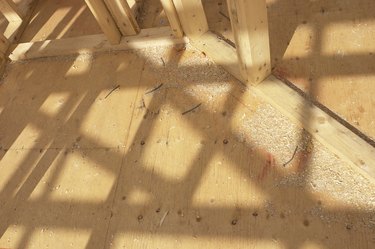Things You'll Need
Three 4-inch by 6-inch beams
Measuring tape
Ladder
Table saw
Construction adhesive
Rafter ties
Wood screws
Cordless drill
Screw driver bit
2 hydraulic jacks
Jigsaw

Sagging floors are often the symptoms of structural damage to the floor joists below the surface. Termites can rot or damage the joists, typically made of wood, rendering the pieces unable to hold up the floor. To prevent the collapse of your second story or injury from falling through a rotten floor, you must repair the joists as soon as possible. Proper repairs often require a contractor or structural engineer. Have your home inspected before beginning your repair to ensure the repair work will be sufficient.
Step 1
Locate the damaged floor joist and measure the length of the damaged area. Cut one of your 4-inch by 6-inch beams to a length about six inches longer than your measurement. Measure the length of the beam on the left of the sagging beam. Cut your second 4-inch by 6-inch beam to equal the length of the beam. Measure the length of the beam on the left of the sagging beam. Cut your third beam to equal this length.
Video of the Day
Step 2
Hoist the 4-inch by 6-inch beam to the floor joist on the right of the damaged beam. Secure the new beam to the old beam using construction adhesive. Cover one side of the beam with the adhesive and press it in place. Further secure the beam, screwing rafter ties through the new beam into the old support beam. Fit your drill with a screwdriver bit and use wood screws to secure the rafter ties. Apply a rafter tie to the opposite end of the joist.
Step 3
Repeat Step 2, this time applying an additional support beam to the beam on the left of the sagging beam.
Step 4
Set up hydraulic jacks, positioning one in the center of the support beam on the right of the sagging beam. Position the second jack in the center of the support beam on the left. Determine how much the joists have sagged. Lift the jacks one-eighth of the total amount.
Step 5
Repeat Step 4, lifting the jacks one-eighth of the total amount each day for eight days. By slowing lifting the second story, you are able to correct the sagging without causing more damage.
Step 6
Hoist the remaining beam to the damaged beam. Center the new beam so it extends 3 inches beyond the damaged area on both sides. Coat the 3-inch extension with construction adhesive and press against the good section of the damaged beam. Repeat on the opposite side. Secure by screwing rafter ties to the repaired beam.
Step 7
Use a jigsaw to cut away severely rotted or damaged areas of the original floor joist. Be sure to remove any wood that was previously water damaged or infested with termites, since it could cause problems with the repaired beams.
Warning
As you slowly lift the jacks, listen for any unusual noises. Cracking and popping noises could indicate your beams are breaking. If these noises are heard, exit the home immediately and contact a professional. Termite and water problems are two of the most common causes of sagging wood. These problems need to be corrected before repairing your floor joists.
Video of the Day